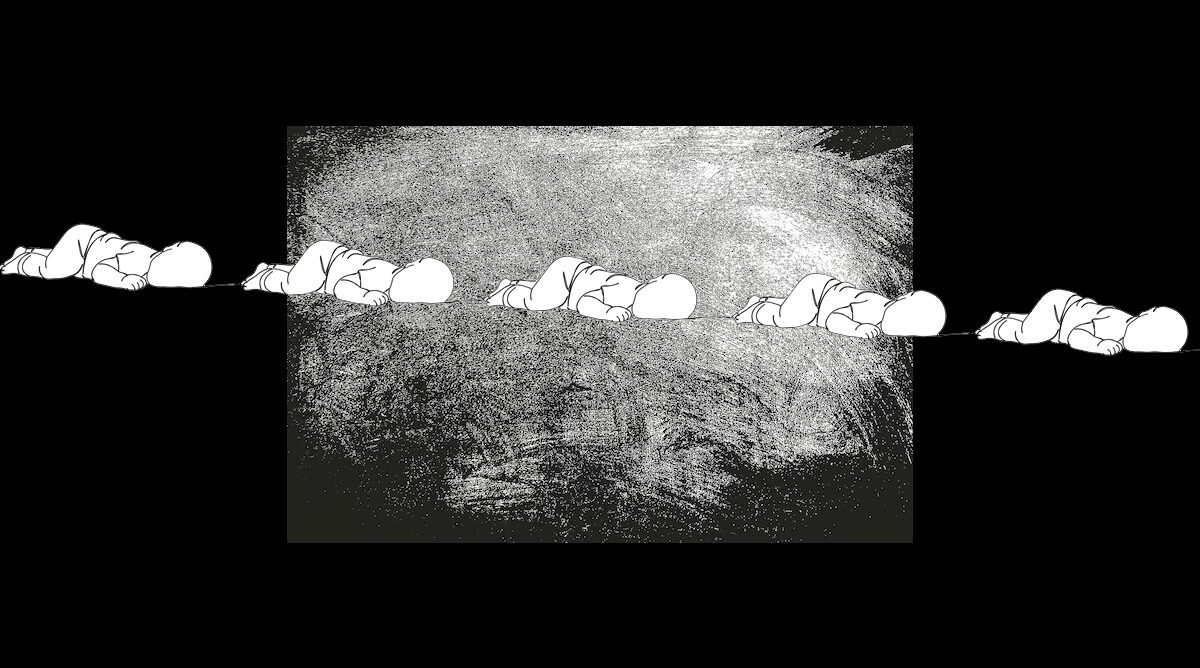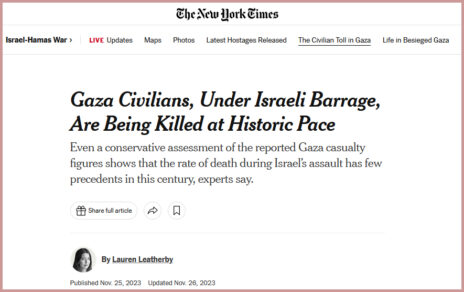On Saturday (11/25), the New York Times published an article by Lauren Leatherby, according to which "even by a conservative assessment", the rate of killing of civilians in Gaza by Israel is almost unprecedented in this century, even compared to the killing of Ukrainian civilians by the Russian army.
This is a blatantly unfounded statement, and the Times was forced to publish a correction. That said, the fundamental problem in the article was not corrected, and the newspaper did not take responsibility for the error.
When the article was published, the Israeli military blogger David Lisovtsev was quick to point out that in Mariupol alone, the Russians killed more civilians than the number claimed by Hamas in the current war in the Gaza Strip. The Times chose the UN estimate, according to which the Russians killed about 1,000 civilians in the city, even though the UN itself stated that this is a preliminary estimate and that it does not know how many civilians were killed in the besieged city because Russians did not allow them access to it.
The real numbers are higher than these estimates. By how much? By 25-100 times higher. The Times itself previously published an estimate by the Ukrainian authorities in the city, according to which about 20,000 civilians were killed in the Russian attack. Later, the Ukrainian government reported 25,000 dead civilians, but mass graves and bodies that have continued to be discovered among the ruins have increased the number even more. According to AP news agency, the number of civilians killed is about 75,000. Ukrainian activists claimed that the number is higher and it is around one hundred thousand victims.
The misrepresentation by the Times in connection with Ukraine does not seem to be coincidental. The careful criterion chosen by the Times, which concerns the "rate" of the killings and not the number and which limits the comparison period to the last 23 years, seems tendentious. The alleged number of 10,000 civilians killed in Gaza by the IDF, which itself has not yet been verified, is dwarfed by other wars since World War II (during which at least hundreds of thousands of civilians were killed by the allied forces), when the rules of war regarding civilians were established in the Fourth Geneva Convention.
The US killed at least tens of thousands of civilians in the Vietnam War, and according to strict estimates, the number reached over 180,000. In Afghanistan, the US killed at least 46,000 civilians directly, and hundreds of thousands more died indirectly as a result of the bombings and fighting. In the two Iraq wars initiated by the USA, 187–210 thousand civilians were killed, and possibly even more. In 2006, about 30,000 civilians were killed; in 2007, about 26,000; and in 2014, about 20,000.
The US wars following the 9/11 attacks claimed the lives of approximately 400,000 citizens directly, and approximately 3.5 million people died indirectly, according to Brown University's "Cost of War" project (which the Times acknowledged as a reliable source: an expert from the institute is quoted in the article).
Of course, not only the US kills civilians during wars. For example, the civil war in Sri Lanka, which ended in 2009, claimed the lives of approximately 170,000 civilians, according to the International Truth and Justice Commission project established in 2013. The Syrian civil war, in the second decade of the twentieth century, claimed the lives of between 700,000 and more than 900,000 people. According to the UN, more than 300,000 of the victims were civilians, about 90% of whom were killed by Assad and his allies. In 2014 alone, more than 30,000 civilians were killed. A year before, about 36,000 civilians were killed.
When it comes to the war currently going on in Gaza, the Times also makes concessions in stating the number of civilian deaths in Gaza, even though there is no official information on this, apart from the numbers provided by Hamas, which has a clear interest in inflating the number of civilian deaths compared to the number of fighters.
The Times also cites a figure according to which about 70% of the dead in the Strip are women and children and attributes it to the United Nations. This number comes from the Jordanian diplomat Sima Sami Bahous, director of the United Nations Organization for the Advancement and Empowerment of Women. Bahous made the statement in a speech and did not provide any support or source for it. The organization led by her, it should be noted, criticizes the situation of women in the Gaza Strip but has never referred to the killing and rape of women by Hamas, which can indicate a particular bias from which Bahus suffers.
But let us leave the numbers out of the discussion. After all, the comparison itself is the message to the readers. The Russian army raped women and killed civilians with malice. For example, Lisovtsev notes that about 600 civilians were bombed while taking shelter in a Mariupol theater whose roof was prominently marked with the word "children" in Russian. The preoccupation with the claim of who killed more civilians, the Russian or the Israeli army, is itself misleading since the Times, at least for the time being, does not claim that the IDF is carrying out a deliberate massacre of Gaza's citizens.
And that is precisely the problem. The Times is not making a clear argument, which a newspaper is supposed to do. It is insinuating, which is what propaganda machines do.
The Times, as mentioned, published a correction the next day. A specific paragraph in the article has been corrected to reflect the fact that the Russian military did indeed kill many more civilians than were supposedly killed in Gaza, and did that in a faster “rate”. Although the Times is known for noting at the bottom of every article if a change has been made to it, no matter how minor, in this case, the newspaper chose not to mention that they had changed a material detail. The correction was also not published in other versions of the article, such as the one in the Irish Times or the one in the Seattle Times, and of course, not in its many quotes in the Arab media and on social networks.
but again, It would be a mistake to focus all the attention on a paragraph that the Times admitted was wrong, as it is just one example of misleading assertions, assumptions, and arguments, selective language or irrelevant examples, that combine to associate Israel with war crimes — while avoiding dealing with the question directly and to try to answer it seriously.
For example, the Times does not distinguish between a war waged between countries and a war waged against a terrorist organization, which is not bound by the laws of war. Throughout the article, there is no reference to Hamas as a terrorist organization but only as "Hamas" and an organization that "manages Gaza."
The Times article uses the term "Israel-Gaza war" and not "Israel-Hamas," as if Israel is fighting all of Gaza’s citizens and not Hamas alone, and creates a false impression regarding the goals of the Israeli side, which has withdrawn from Gaza and has (officially, for the time being) no territorial claims regarding the Strip.
In another example, the article claims that during the Iraq war, US military analysts studied the "life patterns" of the citizens before the bombings in order to reduce civilian casualties, and an Amnesty International person is quoted as saying that this is not possible at the rate at which Israel is fighting. Readers are not shown the circumstances. Would the US study the "life patterns" of the Iraqi citizens if it had 240 hostages - among them babies, children, women and elderly people, some of them severely wounded - held in Iraq? The fact that there are Israeli hostages in the Strip is not mentioned in the article at all.
The Times article also does not refer to the fact that Israel is not responsible for every Gazan citizen killed since the beginning of the fighting: nor to evidence that Hamas members are shooting civilians trying to escape from the bombed areas, nor to evidence about the casualties among Gazan citizens from rockets fired by Hamas and Islamic Jihad (as in the famous case of Al-Ahli Hospital).
The Times article mentions war zones like Iraq, Ukraine, and Afghanistan. However, it ignores or downplays the fact that Gaza is not only a much more densely populated area but but also the fact that Hamas uses the population living there as human shields and uses schools and hospitals as well as educational and religious institutions as military sites and headquarters. Even when this is mentioned briefly, it is attributed to the IDF spokesman, despite the many factual proofs that have already been published to this effect, including by the Times itself.
What can be done in the face of enemy fighters who are not concentrated in army camps but live in their homes with their wives and children and go out between lunch and evening prayer to launch rockets from the hiding place next to their house or carry out murderous raids across the border? This is not a rhetorical question. The laws of war are designed precisely to answer such questions, but the Times editorial does not bother to ask or answer them.
By focusing the discussion on the war on comparisons between civilian victims, the Times reporter turns the discussion into a numbers contest. As if the one who killed "only" 10,000 women and children and not 11,000 "came out righteous". It is a competition with no winners—only losers. There is no pride in the fact that there were some who killed more civilians than Israel. The point is that this is not the proper or correct journalistic perspective to deal with the possibility that Israel is committing war crimes, even if the numbers of Lotherby and the New York Times were accurate - and they are not.
War is a terrible thing, and the killing of innocent civilians is a terrible thing, even if the combat was carefully handled according to all the laws of war. But as long as evil exists, fighting it as humanely as possible is the moral path, rather than avoiding war entirely. In a reality where wars are categorically immoral, evil will win because it is not subject to morality.
The manipulative way in which the Times frames the article about civilian victims in the Gaza war reveals that it is not interested in discussing the morality of war but rather in tarnishing Israel with war crimes. If the Times was interested in dealing with the legitimate question "Is Israel committing war crimes," the right thing to do would have been to check with military and legal experts whether Israel is committing war crimes. Instead, the newspaper chose to deal with a different question, to hold a numbers contest and create an innuendo that Israel is indeed committing war crimes without actually validating it.
Therefore, the negligible correction that the Times made in the article is unsatisfactory. Even if the newspaper corrects the rest of the erroneous factual assertions that are based on the mistake it has already corrected (for example, regarding the comparison between the number of children killed in Gaza and the number of children killed in other wars), it would not be enough. The misleading article should be rewritten, using correct facts and relevant background.
In defense of the Times, as also written in the article, the ones who continuously slander Israel are the ministers and Knesset members from Likud, Religious Zionism, and Otzma Yehudit, who repeatedly call for the perpetration of war crimes and seem to confirm the claims that Israel commits them. For that, at least, the New York Times is not responsible.
Translated By Alina Sharon










